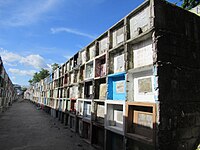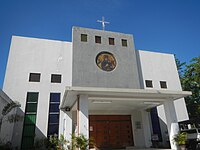San Jose del Monte
San Jose del Monte, officially the City of San Jose del Monte (abbreviated as SJDM or CSJDM; Filipino: Lungsod ng San Jose del Monte), is a 1st class component city in the province of Bulacan, Philippines. According to the 2020 census, it has a population of 651,813 people, making it the largest local government unit within the province of Bulacan and Central Luzon, and the 18th most populated city in the Philippines.
For the other places named "San Jose" in the Philippines, see San Jose (disambiguation).
San Jose del Monte
March 2, 1752
September 10, 2000
December 18, 2003
59 (see Barangays)
Efren C. Bartolome Jr.
Florida P. Robes
261,740 voters (2022)
105.53 km2 (40.75 sq mi)
122 m (400 ft)
1,179 m (3,868 ft)
−1 m (−3 ft)
651,813
6,200/km2 (16,000/sq mi)
156,871
San Joseño
1st city income class
₱ 2,183 million (2020)
₱ 4,120 million (2020)
₱ 1,957 million (2020)
₱ 1,054 million (2020)
San Jose Del Monte City Water District
+63 (0)44
Tagalog
It was proclaimed as a component city on September 10, 2000, through Republic Act No. 8797. Its conversion into a highly urbanized city was by the virtue of Proclamation No. 1057 issued by President Rodrigo Duterte on December 4, 2020; the conversion was rejected on a referendum held on October 30, 2023, by the voters of Bulacan including the concerned city.[5]
Located in the southeast of the province, it is bordered by the cities of Caloocan and Quezon City in Metro Manila to the south, by the town of Rodriguez in Rizal to the east, the towns of Santa Maria and Marilao to the west and Norzagaray to the north. San Jose del Monte is 65 kilometres (40 mi) from Malolos and 30 kilometres (19 mi) from Manila.
The city is home to some of the biggest resettlement areas in the Philippines like the Sapang Palay resettlement area spread over 36 barangays, Pabahay 2000 in Barangay Muzon South, and Towerville in Barangay Minuyan Proper. Most of the city's population come from former informal settlers along the creeks, esteros, riverbanks and railway tracks of Metro Manila.[6]
Etymology[edit]
San Jose del Monte derived its name from Saint Joseph, whose statue was found in a veritable forest. The hunters called it as such, which means “Saint Joseph of the Mountain” in Spanish.








